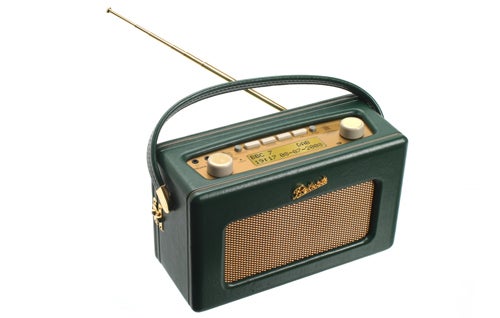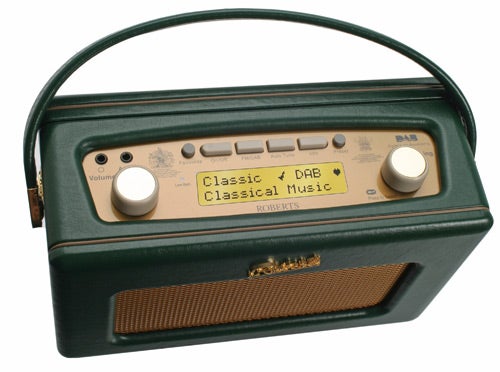Roberts RD-60 Revival DAB Radio Review
Roberts RD-60 Revival DAB Radio
This DAB radio should appeal to those that like a bit of retro styling in their lives.

Verdict
Key Specifications
- Review Price: £145.00
We’re not averse to modernist finishes like glossy plastic, chrome trim, and brushed aluminium but sometimes you just can’t beat the look and feel of natural materials. They not only look great to start with but tend to age well, still looking good tens of years later. As such we love the idea of this DAB radio from Roberts. You still get all the charm of a classic design but with the functionality of a modern product. At least that’s the theory but let’s see if the Revival DAB lives up to its potential.
Well, as you will have guessed we’re completely won over by the Revival’s looks, though we appreciate its going to be far from everyone’s favourite style. Indeed, we’d have to say the abundance of gold is not something that would normally appeal to us but when married with this dark green in particular, we think it works. The leather finish is also available in pink, red, maroon, navy blue, duck egg blue, and cream and there’s a piano black version as well that looks particularly slick, though it is the most expensive of the range. 
Perhaps more important is that those 1950s lines are backed up by superb build quality. The case is made from sturdy MDF (yes, proper wood would have been preferable but it’s still solid stuff) and covered in soft real leather which is finished to a very high standard with all edges neatly tucked under where it meets other surfaces. This leather gives the radio a wonderful tactility that just makes you want to touch it. 
One particular highlight in terms of build quality is the radio’s handle. It’s constructed from some sort of flexible core material wrapped in a thick layer of leather, making it very comfortable to hold, while the large, heavy duty white stitching just adds to the visual appeal. What really finishes it off, though, are the all metal pivoting joints that fix the strap to the side of the radio – these things should last for ever unlike the plastic rubbish you get on so many devices.
One surprising result of Roberts’ resistance to using plastic in this radio’s construction is the way you access the battery compartment – the whole back opens up on a brass piano hinge. From here you can access the speaker and most of the internal electronics, though much of it is protected by plastic boxes so there’s no danger of electrocution here. And, yes, I did say plastic. All the internal sections are made of plastic, including the battery compartment but this is perfectly understandable as it’s all normally out of sight. 
Unfortunately its with the battery compartment that we have our first complaint. Due to the size of the speaker and power of the amplifier, this radio requires quite a bit of juice so in turn needs to use four chunky D-type battery cells to keep it going on the move. At least it can get up to 120 hours use out of a good set. Without batteries the RD-60 weighs 1.5kg and when ready for life on the road this will rise to 1.8kg so this is much more for use down the bottom of the garden or on a caravanning holiday than for packing in your suitcase or backpack.
The RD-60’s controls are all kept up top in a neatly recessed panel. Again we see the presence of some plastic but were Roberts to use a glass panel and machined metal knobs and buttons the cost of this already quite expensive radio would have risen considerably. 
On the left is an analogue volume dial above which sit 3.5mm jack sockets for headphones and an auxiliary input. Across the middle is a row of six buttons that, from left to right, consist of the favourite button, On/Off switch, FM/DAB switch, Auto Tune function, Info switch, and Preset button. Then, finishing things off is the tuning dial/selector button on the right.
Immediately upon seeing this modest selection of controls we realised the RD-60 has limited extra functionality beyond just tuning into a station. Only one Favourite station can be stored (there’s not even one each for FM and DAB, though your one choice can be either), there is no recording facility, and nor is there any pausing/rewinding of live radio. What you can do is whittle down the full list of DAB stations, of which there are hundreds, to a list of your favourites by using the Preset function. You can also choose what DLS information the screen should display using the Info button, while the Auto Tune button will quickly scan for the next station when in FM mode. 
The screen itself is an okay example with an amber backlight that matches the gold colour of the plastic surround surprisingly well. Text is large and clear and viewing angles are decent despite it being an LCD panel. The only major flaw is that the refresh rate is too slow so scrolling text tends to flicker, which can make reading DLS information a bit of a challenge.
Another problem we noted with this radio is that it is very sensitive to phone signal noise so if you use your phone as an MP3 player and plan to plug it into this radio’s auxiliary socket, you’ll have to switch to aeroplane mode. Somewhat making up for this is this radio’s ability to pick up a radio signal; it is easily the most sensitive receiver we’ve tested, picking up many stations even in our office where lesser radios can often fail to pick up anything.
So, with little in the way of features and limited portability the Roberts RD-60 only has two things that can save it. One is the aforementioned design and build quality and the other is of course sound quality and, luckily for Roberts, the RD-60 sounds very good indeed. Thanks to that relatively large speaker this radio can easily fill a sizable room with warm, clear, distortion-free sound. Bass response is admittedly limited with there being no real thump to Dance, RnB, and Rock music and the booming gutsy sections of large orchestral works sounding a little weedy. However, spoken word programmes, lighter classical works, pop, jazz, and acoustic material is all produced with a satisfying degree of warmth and clarity.
”’Verdict”’
The Roberts RD-60 is a bit expensive for what is essentially a very basic DAB radio but, if you like the finer things in life and value that extra touch of craftsmanship, we think it’s definitely worth considering.
Trusted Score
Score in detail
-
Value 7
-
Features 6
-
Design 9

